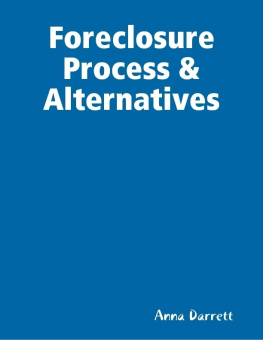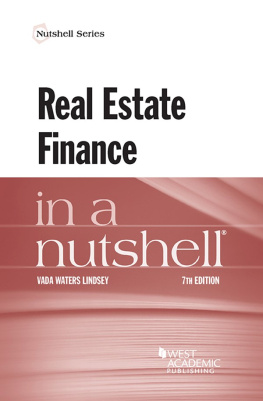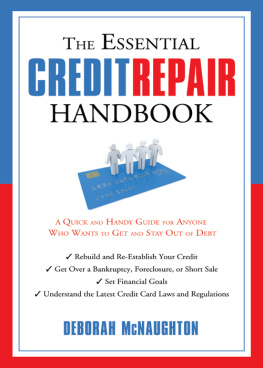Darrett - Foreclosure Process & Alternatives
Here you can read online Darrett - Foreclosure Process & Alternatives full text of the book (entire story) in english for free. Download pdf and epub, get meaning, cover and reviews about this ebook. year: 2015, publisher: Lulu.com, genre: Home and family. Description of the work, (preface) as well as reviews are available. Best literature library LitArk.com created for fans of good reading and offers a wide selection of genres:
Romance novel
Science fiction
Adventure
Detective
Science
History
Home and family
Prose
Art
Politics
Computer
Non-fiction
Religion
Business
Children
Humor
Choose a favorite category and find really read worthwhile books. Enjoy immersion in the world of imagination, feel the emotions of the characters or learn something new for yourself, make an fascinating discovery.
- Book:Foreclosure Process & Alternatives
- Author:
- Publisher:Lulu.com
- Genre:
- Year:2015
- Rating:4 / 5
- Favourites:Add to favourites
- Your mark:
- 80
- 1
- 2
- 3
- 4
- 5
Foreclosure Process & Alternatives: summary, description and annotation
We offer to read an annotation, description, summary or preface (depends on what the author of the book "Foreclosure Process & Alternatives" wrote himself). If you haven't found the necessary information about the book — write in the comments, we will try to find it.
Darrett: author's other books
Who wrote Foreclosure Process & Alternatives? Find out the surname, the name of the author of the book and a list of all author's works by series.
Foreclosure Process & Alternatives — read online for free the complete book (whole text) full work
Below is the text of the book, divided by pages. System saving the place of the last page read, allows you to conveniently read the book "Foreclosure Process & Alternatives" online for free, without having to search again every time where you left off. Put a bookmark, and you can go to the page where you finished reading at any time.
Font size:
Interval:
Bookmark:
Advancement of Claim: In conventional mortgages insured with private mortgage insurance, the PMI Company can advance the money needed to bring the payment current. The home owner will be required to repay the debt, sometimes with no interest charges. An advancement of claim payment may be postponed until the first mortgage is paid off.
Assumption: An owner who purchased a home under a VA or FHA loan may be able to sell the home with an assumption. The new buyer would take over the sellers loan and pay the difference between the selling price and the mortgage amount to the seller. This may be a large amount of money needed as a down payment. Today most if not all loans require the buyer to be mortgage ready prior to assuming a loan ~ the only way its not required is if the original mortgage was dated before 1988. This is an especially attractive loan product when the interest rate on the previous loan is significantly lower than todays rates and can transfer to the new buyer.
Bankruptcy: This is a legal procedure that will stop or postpone a mortgage foreclosure for a period of time. Repayment will be determined following the bankruptcy hearing and the amount and length of time for payment will depend on the type of bankruptcy that is filed (Chapter 7 or 13). A person must hire an attorney in order to file bankruptcy, and the very low cost attorneys begin bankruptcy costs around $1,000.
Deed in Lieu of Foreclosure: In this option the deed is transferred to the lender in exchange for canceling the mortgage debt. This option is good for the seller if there is little or no equity in the home, but is not a good choice when there is a lot of equity. This option is attractive for lenders holding Michigan properties because it takes so long for the foreclosure process to be completed and because property values are on the rise. Even if there is a second mortgage interest in the property, the first mortgage holder may pay off the second interest in order to acquire the property and resell it. With some loan products the lender may be willing to pay the family a nominal amount to sign a deed in lieu.
Forbearance: In forbearance, the lender schedules increased monthly payments for the homeowner so s/he can catch up the past due amount following a period where there is a payment moratorium. Lenders often request 1 times the original payment amount, require a large up front payment (which includes attorney fees), and most often want the loan caught up in 12 months (in some cases 18 months are allowed). The counselor must be very sure the owner can afford to make the additional payment amount every month, which may require a second job or another way to increase in household income. With type two forbearance, the lender can allow a moratorium from payments, schedule a time frame of payments and then structure an advancement of claim or partial claim to catch up the past due amount.
Modification: This option requires changing the terms of the loan by reducing the interest rate or extending the loan term. A modification may work better than a forbearance or repayment plan for many customers experiencing a financial setback, since the resulting payment may be lower. There is usually a cost involved with initiating a modification, which can often be rolled into the loan. Modifications may be used with conventional and government insured loans Past due arrears may be added to the balance to cure the default, but late fees and foreclosure fees must be paid another way (usually an out of pocket expense to the borrower). The home owner must be able to afford the new payment amount (debt to income ratio in line with the loan product) and with some loans the modification may need investor approval. Borrowers will also pay processing and title search fees.
Pre-Sale: A foreclosure pre-sale allows the home owner to sell the home for an amount less than the balance due on a conventional loan. The private mortgage insurance will often subsidize the sale, especially when the house is in a negative equity situation. The seller must sell the home for a price high enough to pay most of the mortgage amount and fees, and the insurer will pick up the remaining balance, sometimes releasing the seller from liability. Borrowers must have experienced a permanent involuntary loss of income and no other alternatives exist to cure the default. Lenders/Servicers agree to this option when the pre-sale will bring in a higher return than the foreclosure will.
Partial Claim: Used in the same manner as an advancement of claim in conventional mortgages, the servicer can bring the loan current by writing a check to themselves, with the past due balance tacked on the end of the loan as a sleeping lien for FHA mortgages. The homeowner will repay this lien once the first mortgage is paid, and if the property is sold prior to the mortgage being repaid, this lien will be paid before funds are disbursed to homeowner. Partial claims are usually considered only after foreclosure has been initiated (that is, after the notice of sale has been sent to the borrower). The borrower must demonstrate that the problem that caused the default has been resolved, and will sign a promissory note to repay the advance. HUD pays lenders a fee to use this program, and HUD money is used to reinstate the loan.
Refinance: Refinancing usually requires substantial equity in the home, a good payment history, and a difference of at least 2% lower interest rate to make the refinancing fees cost effective. A type of refinancing tool known as a stream line refinance is not as costly as regular refinancing, as is available to government insured (FHA) loan borrowers. This is where an FHA loan is refinanced with another FHA loan that has different terms and that result in a lower monthly payment. Interest rates can go up with a streamline refinanced only if no closing costs are charged; otherwise rates can decrease to current market rates. Terms may be extended to 30 years or 12 years past the current term, whichever is less. Borrowers must be two months or less delinquent, and are allowed to bring in payments to make the loan no more than two months behind.
Refunding: In a VA loan, the VA has the authority to buy a loan from the lender and take over the servicing. This happens rarely and only when it can be determined that the home owner is only temporarily unable to make the payments, will make them again in the future, and the lender can no longer extend repayment flexibility (i.e., forbearance and modification cannot be used again).
Repayment Plan: This is when a borrower experiences a temporary financial problem and a workout plan is developed to reinstate the mortgage by adding additional partial payments to the current payment. The borrower must be able to afford the higher payment for the period determined by the lender, and counselors should push for repayment periods to be extended when the payment is unaffordable. Many servicers will resist agreeing to extension but are often able to do so without permission from the lender or investor.
Rural Development (RD) Loss Mitigation Options: Rural Development loans have many foreclosure prevention options for their borrowers built into their programs. Following is a brief description of the options that may be available to a customer with an RD loan:
Delinquency Workout Agreements : Repayment of delinquent mortgage amounts over an extended period of time.
Interest Credit Payment Assistance Subsidy : Interest subsidies may be increased in order to make payments more affordable during difficult financial times.
Payment Moratorium : Monthly payment reductions that can last up to two years, after which time RD will recalculate loan to include remaining past due amount. If payments remain unaffordable, some interest can be cancelled.
Protective Advance : RD will sometimes advance money to pay for taxes or insurance and then recalculate the loan balance and/or extend the payment period.
Font size:
Interval:
Bookmark:
Similar books «Foreclosure Process & Alternatives»
Look at similar books to Foreclosure Process & Alternatives. We have selected literature similar in name and meaning in the hope of providing readers with more options to find new, interesting, not yet read works.
Discussion, reviews of the book Foreclosure Process & Alternatives and just readers' own opinions. Leave your comments, write what you think about the work, its meaning or the main characters. Specify what exactly you liked and what you didn't like, and why you think so.







